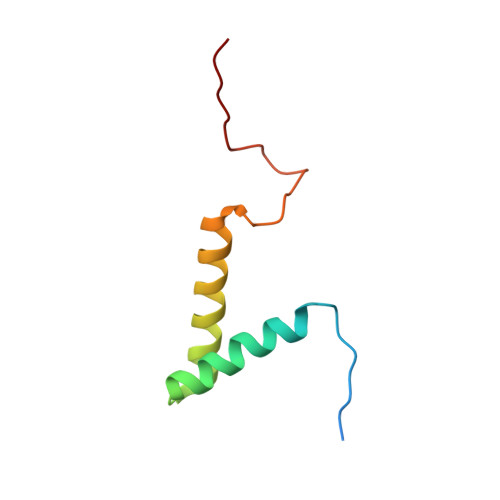Beyond PKA: Evolutionary and structural insights that define a docking and dimerization domain superfamily.
Dahlin, H.R., Zheng, N., Scott, J.D.(2021) J Biological Chem 297: 100927-100927
- PubMed: 34256050
- DOI: https://doi.org/10.1016/j.jbc.2021.100927
- Primary Citation of Related Structures:
7MY4 - PubMed Abstract:
Protein-interaction domains can create unique macromolecular complexes that drive evolutionary innovation. By combining bioinformatic and phylogenetic analyses with structural approaches, we have discovered that the docking and dimerization (D/D) domain of the PKA regulatory subunit is an ancient and conserved protein fold. An archetypal function of this module is to interact with A-kinase-anchoring proteins (AKAPs) that facilitate compartmentalization of this key cell-signaling enzyme. Homology searching reveals that D/D domain proteins comprise a superfamily with 18 members that function in a variety of molecular and cellular contexts. Further in silico analyses indicate that D/D domains segregate into subgroups on the basis of their similarity to type I or type II PKA regulatory subunits. The sperm autoantigenic protein 17 (SPA17) is a prototype of the type II or R2D2 subgroup that is conserved across metazoan phyla. We determined the crystal structure of an extended D/D domain from SPA17 (amino acids 1-75) at 1.72 Å resolution. This revealed a four-helix bundle-like configuration featuring terminal β-strands that can mediate higher order oligomerization. In solution, SPA17 forms both homodimers and tetramers and displays a weak affinity for AKAP18. Quantitative approaches reveal that AKAP18 binding occurs at nanomolar affinity when SPA17 heterodimerizes with the ropporin-1-like D/D protein. These findings expand the role of the D/D fold as a versatile protein-interaction element that maintains the integrity of macromolecular architectures within organelles such as motile cilia.
- Department of Pharmacology, University of Washington, Seattle, Washington, USA.
Organizational Affiliation:
















